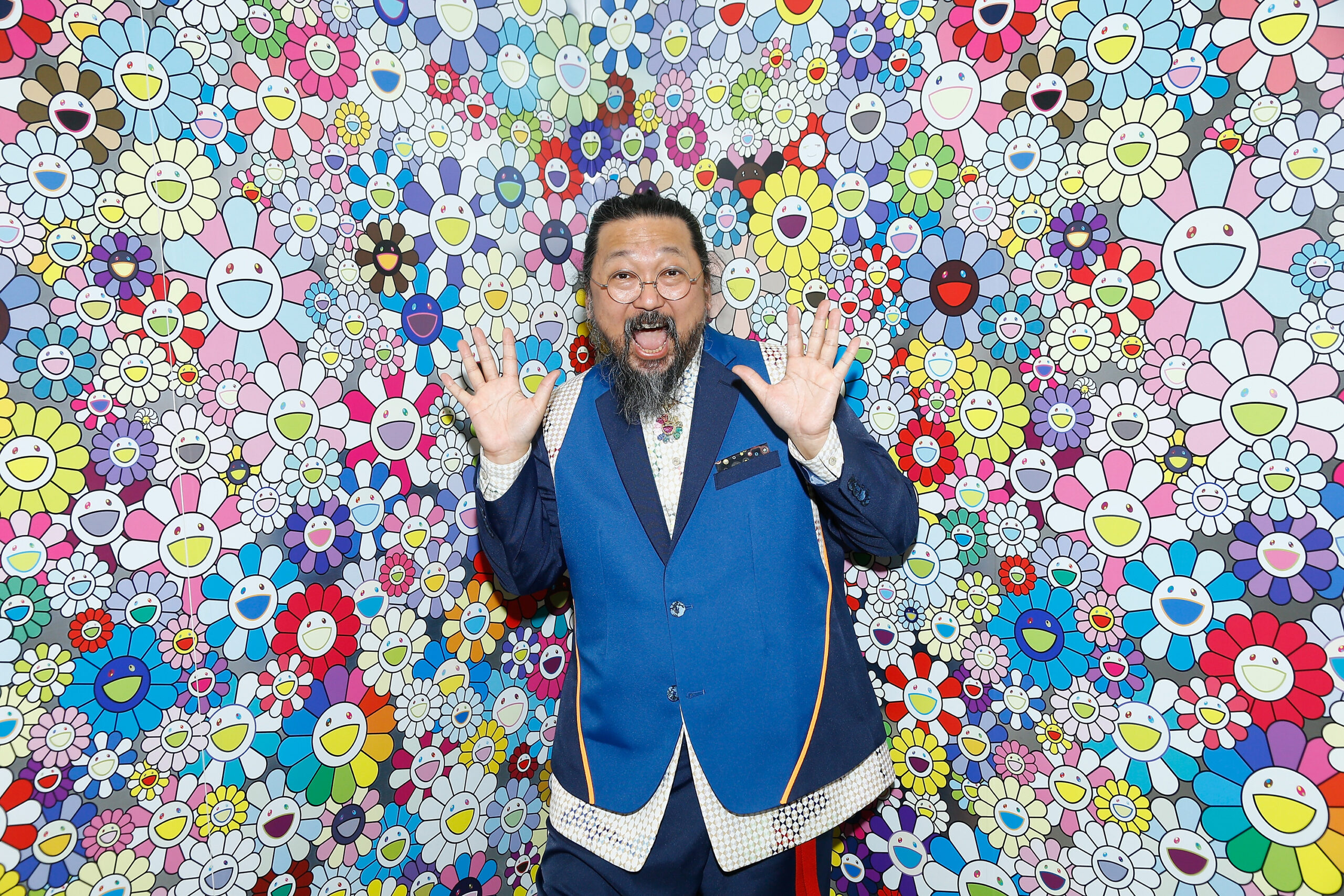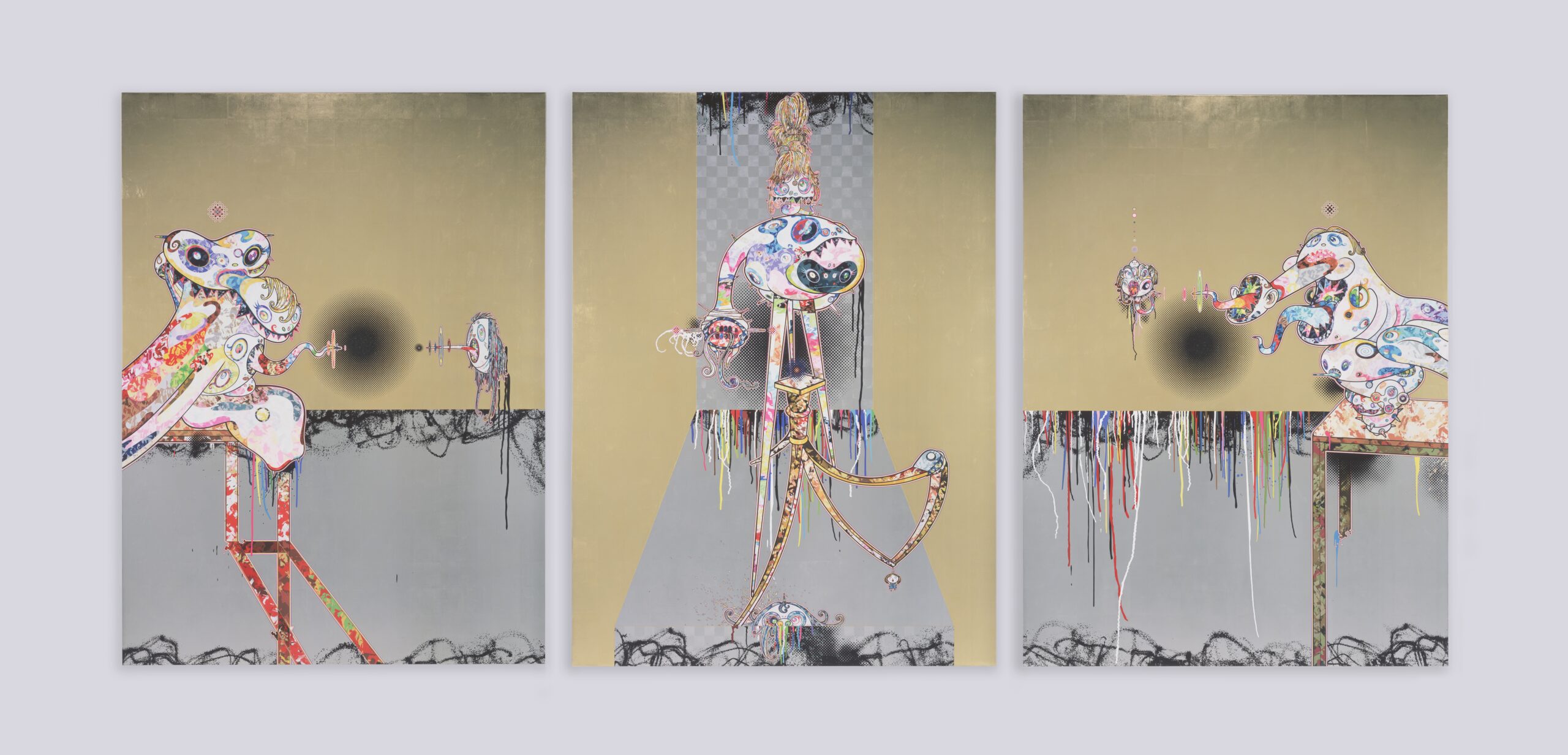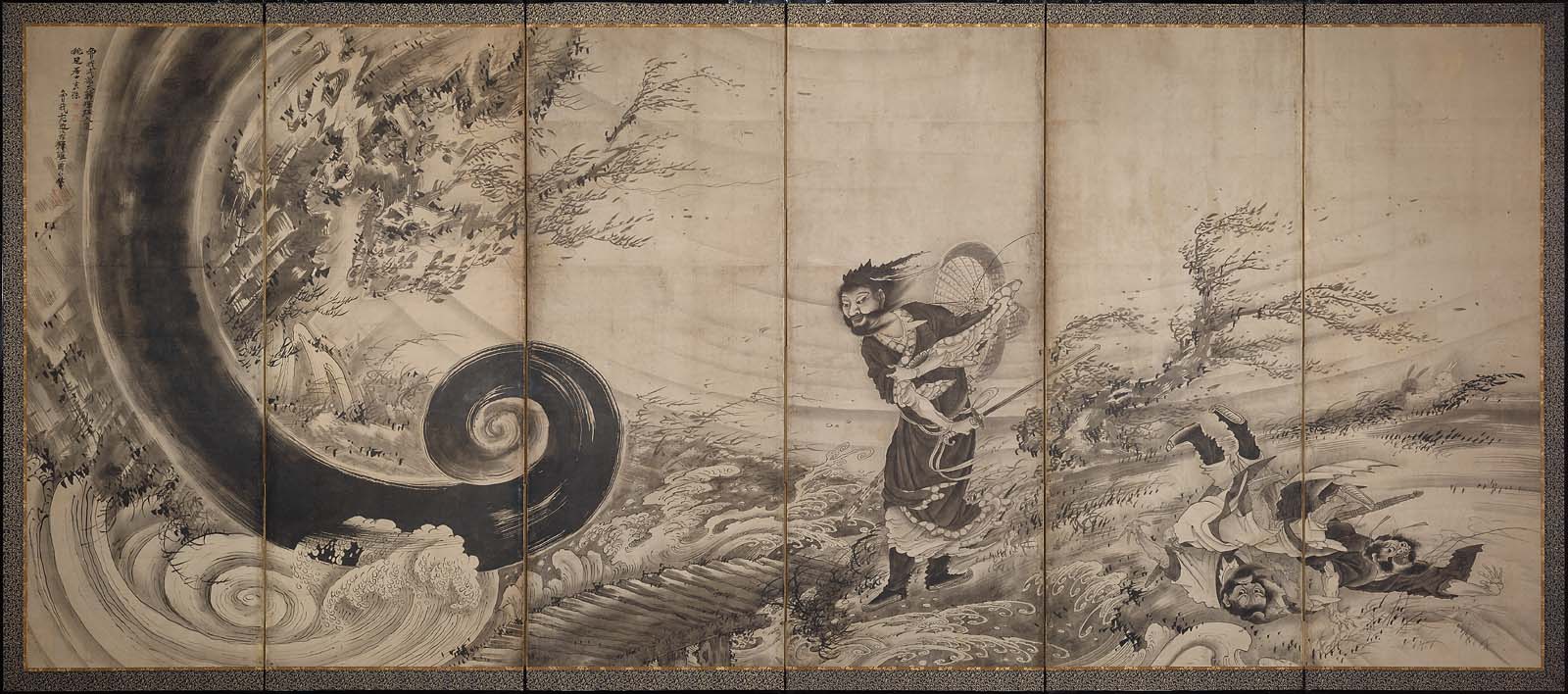To those unfamiliar with Takashi Murakami, his art can seem almost psychedelic, bursting with color and manga-inspired designs. The 56-year-old is sometimes called the “Warhol of Japan” and his work, like Andy Warhol’s, is characterized by a postmodern project of uniting kitschy, mass-produced pop culture with high art. He is perhaps best known for his trademark “superflat” drawings and paintings; the name refers to the tradition of two-dimensionality that Murakami detects in traditional Japanese art as well as to the shallowness of Japanese consumer culture, which he playfully critiques. A couple of years ago, a pop-up café in Tokyo was dedicated entirely to his work, with even the hamburger buns imprinted with his signature smiling flower faces. A few years before that, Murakami’s work graced—or disgraced, depending on your view—the royal apartments at Versailles.
Murakami’s company, Kaikai Kiki—part art studio, part promotional and merchandising business—has offices in both Tokyo and New York. As the New York Times noted in 2005, Kaikai Kiki is run much like a factory, with long hours, timecards, and training manuals. With dozens of artists following his lead, Murakami creates large, fantastical paintings as well as sculptures of acrylic and fiberglass that meld manga (comics) and anime (cartoons) with traditional Japanese styles. He has risen to the level of contemporary art superstar by dint of hard work, originality, and a deep understanding of both historical and contemporary art traditions, Japanese and Western. Unlike Warhol, whose art largely commented on perception and commodification, or Roy Lichtenstein, whose merging of ad speak and comic-book imagery tried to blur the boundaries between the high and the low, Murakami’s work draws deeply from historical traditions. (In fact, Murakami holds a Ph.D. from Tokyo University in the traditional Japanese painting technique called Nihonga.) Murakami’s blending of new pop subjects with inherited themes results in projects that are sometimes immediately recognizable, sometimes strange and otherworldly.

Among the pieces in Murakami’s 2010-11 Versailles show were person-sized statues of his characters Kaikai and Kiki, perfect embodiments of the Japanese notion of kawaii, which in essence means cute or adorable. A cartoon-like alien character in white clothing, Kaikai sports a pink babyface and bunny ears. At Versailles he stood mischievously on a small multicolored patchwork globe holding a long, thin red staff in his right hand with three human skulls attached at the top. Kiki, similarly shaped and sized, with smaller bunny ears—and with fangs and three eyes—stood on another globe nearby. The incongruity of these brightly colored pieces with the classical statues and busts behind them (see picture above) and the baroque splendor of Versailles enhanced their kawaii-ness. Another piece, Oval Buddha Gold, looked down on the Versailles gardens. A huge golden idol of Buddha sitting on a pillar, from one side the statue looks placid and might be mistaken for a cartoonish nod to the lavish statuary of Versailles. But it has a second face on the other side, with big eyes and pointy teeth jutting out like missiles in crude—and humorous—mockery. The most overtly sexual of Murakami’s works at Versailles, Miss Ko2, is a tall statue of a leggy, busty blonde waitress or maid with a Barbie-doll smile; she greeted exhibition visitors with an outstretched arm. She is clearly parodic, a comment on both Western ideals of beauty and how they have in turn been incorporated into Japanese pop culture. To fully understand the layers of tribute and parody in this statue—and indeed in much of Murakami’s work—would require the knowledge and mindset of an otaku, a hardcore fan of manga or anime.
Murakami’s most notorious manga-inspired works are Hiropon (1997) and My Lonesome Cowboy (1998), jubilantly cartoonish and pornographic statues representative of, yet also mocking, the kinds of extremely sexualized figures in some Japanese comics. Hiropon is an outrageously proportioned and scantily clad young woman. My Lonesome Cowboy, perhaps Murakami’s most daring and fantastic creation, is a nude young man; the title is a reference to Andy Warhol’s satirical Western Lonesome Cowboys. In each statue, exploding bodily fluid is comically used as an object (milk as a jump rope, semen as a lasso). The works bring together such diverse elements—from manga aesthetics and Jeff Koons-like sculptural execution to the incorporation of a certain raunchy gay culture—that they become almost visually overdetermined. They are provocative and funny, erotic and disturbing.
Much of Murakami’s art draws on recurring characters and faces, like the omnipresent smiling flowers, which can seem not just kawaii but downright disturbing: When reproduced by the hundreds on a huge wall, the smiles, friendly at first, eventually seem to mock the viewer. His best-known creation, “Mr. DOB,” is complex in a way that is typical of Murakami. Created in 1993 as an alter ego of sorts, its circular head and features—with the letters D and B written on ears that suggest Mickey Mouse—spell out its name, a contraction of the Japanese nonsense sentence Dobojite dobojite (Why? Why?) and the comic catchphrase oshamanbe. With a wide, Cheshire-cat grin, Mr. DOB is patently absurd. Its appearance in Murakami’s art ranges from the whimsical to the twisted and demoniacal.
From 2009 to 2011, Murakami engaged in a Nippon E-awase (a Japanese picture contest) with the country’s highly regarded art historian Nobuo Tsuji. Traditionally Nippon-e-awase involved a court dialogue between, say, an emperor and a famous artist who would then undergo a scathing critique. In this contemporary version, Tsuji presented works by famous Japanese artists through the centuries and Murakami returned with ingenious riffs on them. Some of the works to emerge from this project were radically different from the originals. Other responses came back only slightly different, like Murakami’s take on Hakuin Ekaku’s Half-Length Portrait of Daruma, an 18th-century depiction of an important Buddhist monk with a pronounced overbite. Murakami’s version is shadowed darker but is remarkably similar to the source material—yet it seems like a more textured caricature, and is more compelling.
Some of Murakami’s latest work explores his own role in the art world and his relationship to other contemporary artists. His recent series of Baka (Idiot) Paintings have his own stylized face at the center. The first of the series, Idiot, is apparently a sort of artist’s manifesto; it contains text bemoaning the lack of dynamism in contemporary Japanese art. The word Baka is scrawled at the top of the painting like a watermark, with the artist’s tiny bespectacled visage ironically set off from both the text itself and the piece’s title.

An exhibition this spring of Murakami’s work at Manhattan’s Galerie Perrotin, sprawling across three floors, included an homage-with-a-twist to the 20th-century English artist Francis Bacon, known for his bloody, raw representations of crucifixions and the twisted, gnarled faces in many of his portraits. The paintings in the exhibition contained many Murakami tropes: eyes, mushrooms, characters, all enshrined in multiple layers of platinum leaf. The results are strange, colorful, manga-inspired creatures, funny and frightening at once. Lovers of Bacon may find it hard to recognize anything in these compositions that reminds them of his work, but that is part of the fun. In the first panel of Homage to Francis Bacon (Second Version of Triptych (on light ground)), the main character or monster sits grumpy, menacing, and alight in color, decorated in twirls and waves and other elements taken from classic Japanese art. In the middle of the triptych, the main character, perhaps part chandelier with multiple heads and eyes, appears stacked low to high; in the third panel, tentacles come out of the many-mouthed, many-visaged character, heads with tongues thrusting out toward a circle—a ball of fuzz? a black hole?—with a small drone-like creature floating to the left. The colors are bubblegum spectrum and manga-inspired; these monstrosities, like so much of Murakami’s work, combine the grotesque and the comic.


Another recent Murakami work in the Perrotin exhibition—the 33-foot-long Transcendent Attacking a Whirlwind, made up of 10 wood panels—is simply spectacular. It is painted in acrylic and highlighted in gold and platinum leaf, and is an homage to a famous screen by the same name from about 1764 by the Edo master Soga Shohaku (pictured at right). In Murakami’s version, a red dragon caught in a storm is surrounded by characters in traditional dress. The composition is all circles and swirls that emphasize the drama—the dragon’s tail merges into the waves as more swirls fall from the sky and leap up from the ocean. Two men, one to the extreme left of the composition and the other to the extreme right, seem to do battle from afar with the dragon, somehow unleashing the swirls of color and aggression onto the monster. They also remind the viewer of Greek gods—the man to the left could well be Zeus. An homage to Japanese scroll paintings, part of the beauty of this work lies in the fact that it can be read on multiple levels: as a response to a long-gone Japanese painter but also as a response to concerns of the here and now—violence, societal conflicts, and other not-at-all-mythical worries.
Murakami repeatedly expressed a sense of debt and obligation to Professor Tsuji in their Nippon-e-awase for helping him hone his talents and creativity while recalling hundreds of years of Japanese art history. Even in his latest work, we continue to see a constant back-and forth between traditional and new. Like some giant manga Shiva, Murakami is a creative force who takes in, processes, and ejects the once familiar, creating a new hybrid. His work is fascinatingly odd, sometimes unsettling, infinitely generative, and in any case unique.

